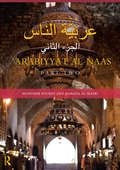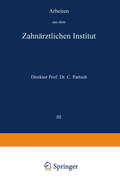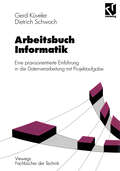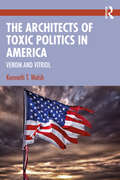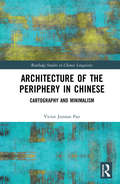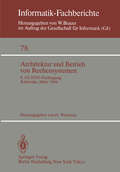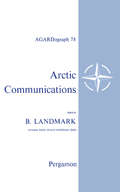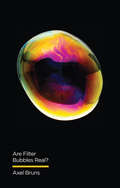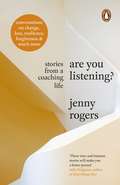- Table View
- List View
Arabic Media Dictionary
by El Mustapha LahlaliArabic Media Dictionary is designed to equip students with translations of terms from Arabic into English. Covering Arabic language mass media, this up-to-date dictionary enables easy reference of media terminologies and phrases, and the acquisition of a wide range of terms related to different media themes and registers. This dictionary offers a wide range of Arabic media entries, which have been translated and contextualised in authentic Arabic media texts, some of which have been extracted from Arabic newspapers and online Arabic media sources. Containing more than 6500 entries with sample sentences, this dictionary is a vital reference for students of Arabic translation, journalists, Arabic instructors and learners of Arabic at intermediate and advanced levels. The dictionary is structured in alphabetical order, accompanied with an Arabic index for easy access.
Arabic Translation Across Discourses (Routledge Studies in Language and Identity)
by Said FaiqA rare contribution to global translation as a ‘cross-cultural-open-concept’, Arabic Translation Across Discourses provides explorations of Arabic translation as an instance of transcultural and translingual encounters (transculguaging). This book examines the application and interrogation of discourses of translation in the translation of discourses (religion, literature, media, politics, technology, community, audiovisual, and automated systems of communication for translation). The contributors provide insights into the concerns and debates of Arabic translation as a tradition with local, yet global dimensions of translation and intercultural studies. This volume will be of great interest to students and researchers of all translation studies, but will also provide a rich source for those studying and researching history, geopolitics, intercultural studies, globalization, and allied disciplines.
Arabic Translation Across Discourses (Routledge Studies in Language and Identity)
by Said FaiqA rare contribution to global translation as a ‘cross-cultural-open-concept’, Arabic Translation Across Discourses provides explorations of Arabic translation as an instance of transcultural and translingual encounters (transculguaging). This book examines the application and interrogation of discourses of translation in the translation of discourses (religion, literature, media, politics, technology, community, audiovisual, and automated systems of communication for translation). The contributors provide insights into the concerns and debates of Arabic translation as a tradition with local, yet global dimensions of translation and intercultural studies. This volume will be of great interest to students and researchers of all translation studies, but will also provide a rich source for those studying and researching history, geopolitics, intercultural studies, globalization, and allied disciplines.
Arabiyyat al-Naas (Part Two): An Intermediate Course in Arabic
by Munther Younes Hanada Al-MasriArabiyyat al Naas (Part Two): An Intermediate Course in Arabic offers a vibrant course in Arabic as it is written and spoken today by educated native speakers. Not only does it continue the innovative integration of Modern Standard Arabic (MSA) and Levantine Arabic used in Part One of the series, but it does so in a way that supports and develops students’ increased mastery of the language. Combining a greater focus on cultural topics with an increased coverage of MSA, Part Two introduces more sophisticated communication, giving students a deeper awareness of the cultural base of the Arabic language. Features include: Twenty-one theme-based units covering a wide range of relevant and engaging topics, including education and learning, jobs and professions, the Arab woman, religion, money and the economy, politics and government and the environment Thorough coverage of listening, speaking, writing and reading skills in every unit, with lessons structured to provide students with variety, stimulation and further opportunities for practice Humorous, realistic dialogues reflecting everyday educated speech among Arabs to build up strong and practical communication skills A rich variety of reading passages, including poems, short stories, newspaper articles, descriptions of Arab cities and biographies of famous figures, designed to improve comprehension and analytical skills and to deepen students’ knowledge of Arab history, culture, language, and literature An extensive range of appealing exercises and activities, including crossword puzzles, root-and-pattern identification exercises, passage completions, guided and free compositions, and songs Free accompanying CD that includes audio recordings of the listening materials in the 21 units and a number of songs tied to their themes Free companion website (www.routledge.com/cw/younes) featuring the texts of the listening passages, the audio recordings available on the CD , a track list of all the audio materials, the answer keys to the crossword puzzles, sample tests and language games. Developed by an experienced and dynamic author team and tested over a number of years at Cornell University, Arabiyyat al Naas (Part Two) will be an essential resource for intermediate-level students of Arabic. While primarily designed for classroom use, the accessibility of the course also renders it highly suitable for independent study. This volume is the second in a pioneering three-part series of Arabic textbooks which together provide a complete three-year undergraduate language program.
Arbeitsbuch Informatik: Eine praxisorientierte Einführung in die Datenverarbeitung mit Projektaufgabe (Viewegs Fachbücher der Technik)
by Gerd Küveler Dietrich SchwochLehrbuch für Erstausbildung in der Datenverarbeitung mit Projektaufgabe: Aufbau und Test einer meßtechnischen Schnittstellenkarte für den PC. Alle grundlegenden Themengebiete sind hier in einem Band vereinigt: Grundprinzipien, Umgang mit DOS, Programmieren mit Turbo Pascal, Mikrocomputersysteme, Betriebssysteme und Rechnernetze.
Architecting Salesforce Success: Quick tips to help you kickstart your career as a Salesforce Architect
by Amit ChaudharyAccelerate your career by understanding what it takes to grow within the Salesforce ecosystemKey FeaturesFind out what skills are required to become a Salesforce ArchitectGain insights into the role of an architect and their day-to-day responsibilitiesLearn from best practices and find out how to avoid common mistakes to build a successful careerPurchase of the print or Kindle book includes a free PDF eBookBook DescriptionSalesforce stands as a leading cloud-based customer relationship management (CRM) platform with extensive support for businesses in managing their sales, marketing, customer service, and other critical activities. Becoming a Salesforce Architect opens doors to lucrative career opportunities in a thriving industry, given the high demand for skilled professionals. This guide offers expert insights and best practices for developers who want to ascend the Salesforce ladder, technical leads honing their prowess in Salesforce, and enthusiasts exploring the dynamic world of Salesforce architecture. Whether you’re seeking a roadmap to success as a Salesforce Architect or want to enhance your skills, this concise yet insightful report ensures your growth in the vibrant Salesforce community. This guide will help you change your mindset from developer to architect, highlighting key considerations when designing a solution for clients. By the end of this book, you’ll have gained a comprehensive understanding of the role of a Salesforce Architect and the prerequisites and essential soft skills necessary for success within the Salesforce ecosystem.What you will learnBuild the soft skills necessary for success as a Salesforce ArchitectDevelop an architectural mindset to approach projects effectivelyAvoid common mistakes made by Salesforce architectsMaster essential hacks and strategies used by for Salesforce ArchitectsLeverage the tools, extensions, and plugins at your disposalWho this book is forIf you’re a technical lead or developer looking to enhance your skills, or an enthusiast exploring architect roles within the Salesforce ecosystem, this book is for you.
Architecting User-Centric Privacy-as-a-Set-of-Services: Digital Identity-Related Privacy Framework (Springer Theses)
by Ghazi Ben AyedHow could privacy play a key role in protecting digital identities? How could we merge privacy law, policies, regulations and technologies to protect our digital identities in the context of connected devices and distributed systems? In this book, the author addresses major issues of identity protection and proposes a service-oriented layered framework to achieve interoperability of privacy and secure distributed systems. The framework is intended to distill privacy-related digital identity requirements (business interoperability) into a set of services, which in turn can be implemented on the basis of open standards (technical interoperability). The adoption of the proposed framework in security projects and initiatives would decrease complexities and foster understanding and collaborations between business and technical stakeholders. This work is a step toward implementing the author’s vision of delivering cyber security as a set of autonomous multi-platform hosted services that should be available upon user request and on a pay-per-use basis.
The Architects of Toxic Politics in America: Venom and Vitriol
by Kenneth T. WalshThe Architects of Toxic Politics in America: Venom and Vitriol explains the history of poison politics in America by profiling some of the key political “attack dogs” who have shaped the modern landscape.Comparing and contrasting the Trump and Biden presidencies with administrations of the past, the book explains the unique character of the current toxic political moment and the forces that have created it. The book also focuses quite extensively on “non-presidential” architects of toxic politics: other politicians, campaign strategists, activists, and media figures (and a few key figures that have fulfilled two or more of these roles). Drawing on his long career as a journalist specializing in presidential coverage, Kenneth T. Walsh argues that due to the complex, often conflicting nature of American government, the angriest, most decisive voices can command media, voter, and legislative attention and thereby maintain and consolidate power. This results in frustration, alienation, and cynicism—and ultimately, a diminishment of voter participation that can reinforce the vicious cycle and lead to electoral disaster.For anyone interested in politics, media, and the culture of “gotcha” journalism, this book will also be a valuable addition to undergraduate and graduate courses on politics, the presidency, political and media ethics, campaign history and government.
The Architects of Toxic Politics in America: Venom and Vitriol
by Kenneth T. WalshThe Architects of Toxic Politics in America: Venom and Vitriol explains the history of poison politics in America by profiling some of the key political “attack dogs” who have shaped the modern landscape.Comparing and contrasting the Trump and Biden presidencies with administrations of the past, the book explains the unique character of the current toxic political moment and the forces that have created it. The book also focuses quite extensively on “non-presidential” architects of toxic politics: other politicians, campaign strategists, activists, and media figures (and a few key figures that have fulfilled two or more of these roles). Drawing on his long career as a journalist specializing in presidential coverage, Kenneth T. Walsh argues that due to the complex, often conflicting nature of American government, the angriest, most decisive voices can command media, voter, and legislative attention and thereby maintain and consolidate power. This results in frustration, alienation, and cynicism—and ultimately, a diminishment of voter participation that can reinforce the vicious cycle and lead to electoral disaster.For anyone interested in politics, media, and the culture of “gotcha” journalism, this book will also be a valuable addition to undergraduate and graduate courses on politics, the presidency, political and media ethics, campaign history and government.
The Architectural and Technological Revolution of 5G
by José Luiz Frauendorf Érika Almeida de SouzaThe book discusses the evolution of cellular technology, then focusing in on 5G and its architecture and what it means for current engineers. The book first focuses on 4G and how it changed the industry, allowing people to communicate by connecting devices to the internet. The authors detail the emergence of services and applications that have revolutionized communication and continue to impact the daily habits of majority of the world's population. The authors endeavor to tell this story by showing the path taken until the arrival of 5G, detailing how technological and architectural progress evolved in all these years. It is a technical book, but the authors take care to explain in detail each aspect related to technology in order to allow everyone interested in the subject to delve into this important topic.Presents a comprehensive explanation about 4G and 5G architecture, modulation and protocols;Includes a thorough explanation of modern antennas technology and O-RAN;Relevant to technology professionals and students interested in 5G, but with little background in telecommunications;The English translation of this book from its Portuguese original manuscript was done with the help of artificial intelligence (machine translation by the service provider DeepL.com). A subsequent human revision of the content was done by the author.
Architectural Transformations in Network Services and Distributed Systems
by Andriy Luntovskyy Josef SpillnerWith the given work we decided to help not only the readers but ourselves, as the professionals who actively involved in the networking branch, with understanding the trends that have developed in recent two decades in distributed systems and networks. Important architecture transformations of distributed systems have been examined. The examples of new architectural solutions are discussed.
Architectural Wireless Networks Solutions and Security Issues (Lecture Notes in Networks and Systems #196)
by Santosh Kumar Das Sourav Samanta Nilanjan Dey Bharat S. Patel Aboul Ella HassanienThis book presents architectural solutions of wireless network and its variations. It basically deals with modeling, analysis, design and enhancement of different architectural parts of wireless network. The main aim of this book is to enhance the applications of wireless network by reducing and controlling its architectural issues. The book discusses efficiency and robustness of wireless network as a platform for communication and data transmission and also discusses some challenges and security issues such as limited hardware resources, unreliable communication, dynamic topology of some wireless networks, vulnerability and unsecure environment. This book is edited for users, academicians and researchers of wireless network. Broadly, topics include modeling of security enhancements, optimization model for network lifetime, modeling of aggregation systems and analyzing of troubleshooting techniques.
Architecture and Design for the Future Internet: 4WARD Project (Signals and Communication Technology)
by Luis M. M. Correia, Henrik Abramowicz, Martin Johnsson and Klaus WünstelArchitecture and Design for the Future Internet addresses the Networks of the Future and the Future Internet, focusing on networks aspects, offering both technical and non-technical perspectives. It presents the main findings of 4WARD (Architecture and Design for the Future Internet), a European Integrated Project within Framework Programme 7, which addressed this area from an innovative approach. Today’s network architectures are stifling innovation, restricting it mostly to the application level, while the need for structural change is increasingly evident. The absence of adequate facilities to design, optimise and interoperate new networks currently forces a convergence to an architecture that is suboptimal for many applications and that cannot support innovations within itself, the Internet. 4WARD overcomes this impasse through a set of radical architectural approaches, built on a strong mobile and wireless background. The main topics addressed by the book are: the improved ability to design inter-operable and complementary families of network architectures; the enabled co-existence of multiple networks on common platforms through carrier-grade virtualisation for networking resources; the enhanced utility of networks by making them self-managing; the increased robustness and efficiency of networks by leveraging diversity; and the improved application support by a new information-centric paradigm in place of the old host-centric approach. These solutions embrace the full range of technologies, from fibre backbones to wireless and sensor networks.
Architecture and Governance for Communication Services
by Noël Crespi Emmanuel BertinCommunication services are evolving at an unprecedented rate. No longer limited to interpersonal vocal communication, they now integrate functions such as address books, content sharing and messaging. The emergence of social networks – which may also include these features – is an important element of this transformation. Content services are becoming flagship services themselves, and are sometimes paired up with conversation services. The boundaries between different services are becoming less and less distinct. This book meets the need for a better understanding of communication services, and for a general framework of their description. A detailed overview on service architecture in the Telco, Web and IT worlds is presented, offering a roadmap with explanations on how to improve the architecture and governance of communication service architectures by exploiting the syntax and semantics that are common to different services is clearly outlined. This book also responds to recurring questions about service design, such as the functional scope of enablers or SOA (Service Oriented Architecture) services, the relevance of service composition to the user and collaboration between different services in a converged environment. Many concrete examples from telecoms service providers’ operations illustrate these concepts. Contents 1. Describing Service Architectures. 2. Convergence of Service. 3. Building an Architectural Framework for Telecom Services. 4. Modeling and Case Study. 5. Organizational and Software Applications. About the Authors Emmanuel Bertin is senior service architect at Orange Labs in France. He is the author of more than 40 research papers, and holds more than 10 patents in the area of communication services. Noël Crespi worked at Bouygues Telecom, France Telecom R&D, and then at Nortel Networks where he led the Telephony Programme. He is currently Professor and Head of the Service Architecture Laboratory at Institut Mines-Telecom, Telecom SudParis in France and is the author/co-author of more than 160 research papers and 140 contributions in standardization.
Architecture and Governance for Communication Services
by Noël Crespi Emmanuel BertinCommunication services are evolving at an unprecedented rate. No longer limited to interpersonal vocal communication, they now integrate functions such as address books, content sharing and messaging. The emergence of social networks – which may also include these features – is an important element of this transformation. Content services are becoming flagship services themselves, and are sometimes paired up with conversation services. The boundaries between different services are becoming less and less distinct. This book meets the need for a better understanding of communication services, and for a general framework of their description. A detailed overview on service architecture in the Telco, Web and IT worlds is presented, offering a roadmap with explanations on how to improve the architecture and governance of communication service architectures by exploiting the syntax and semantics that are common to different services is clearly outlined. This book also responds to recurring questions about service design, such as the functional scope of enablers or SOA (Service Oriented Architecture) services, the relevance of service composition to the user and collaboration between different services in a converged environment. Many concrete examples from telecoms service providers’ operations illustrate these concepts. Contents 1. Describing Service Architectures. 2. Convergence of Service. 3. Building an Architectural Framework for Telecom Services. 4. Modeling and Case Study. 5. Organizational and Software Applications. About the Authors Emmanuel Bertin is senior service architect at Orange Labs in France. He is the author of more than 40 research papers, and holds more than 10 patents in the area of communication services. Noël Crespi worked at Bouygues Telecom, France Telecom R&D, and then at Nortel Networks where he led the Telephony Programme. He is currently Professor and Head of the Service Architecture Laboratory at Institut Mines-Telecom, Telecom SudParis in France and is the author/co-author of more than 160 research papers and 140 contributions in standardization.
Architecture of the Periphery in Chinese: Cartography and Minimalism (Routledge Studies in Chinese Linguistics)
by Victor Junnan PanArchitecture of the Periphery in Chinese offers a comprehensive survey on the fine structure of the sentence peripheral domain in Mandarin Chinese from a cartographic perspective. Different functional projections hosting sentence-final particles, implicit operators and other informational components are hierarchically ordered according to the "Subjectivity Scale Constraint" functioning at syntax-discourse interface. Three questions will be essentially addressed: What is the order? How to determine such an order? Why such an order? This research not only gives a thorough examination of the peripheral elements in Chinese but also improves the general understanding of the ordering issue in the left-periphery crosslinguistically. This book is aimed at scholars interested in Chinese syntax or generative syntax.
Architecture of the Periphery in Chinese: Cartography and Minimalism (Routledge Studies in Chinese Linguistics)
by Victor Junnan PanArchitecture of the Periphery in Chinese offers a comprehensive survey on the fine structure of the sentence peripheral domain in Mandarin Chinese from a cartographic perspective. Different functional projections hosting sentence-final particles, implicit operators and other informational components are hierarchically ordered according to the "Subjectivity Scale Constraint" functioning at syntax-discourse interface. Three questions will be essentially addressed: What is the order? How to determine such an order? Why such an order? This research not only gives a thorough examination of the peripheral elements in Chinese but also improves the general understanding of the ordering issue in the left-periphery crosslinguistically. This book is aimed at scholars interested in Chinese syntax or generative syntax.
Architectures for Quality of Service in the Internet: International Workshop, Art-QoS 2003, Warsaw, Poland, March 24-25, 2003, Revised Papers (Lecture Notes in Computer Science #2698)
by Wojciech Burakowski Berthold Koch Andrzej BebenThe thoroughly refereed postproceedings of the International Workshop on Architectures for Quality of Service in the Internet, Art-QoS 2003, held in Warsaw, Poland, in March 2003. The 22 revised full papers presented were carefully reviewed and selected for inclusion in the book. The papers are organized in topical sections on architectures for next generation networks, architectures and services, signalling, admission control, AQUILA-resource control, AQUILA-QoS at work, MPLS traffic engineering, and traffic control mechanisms.
Architectures of Small-Cell Networks and Interference Management (SpringerBriefs in Computer Science)
by Duy Trong Ngo Tho Le-NgocThis Springer Brief presents the architectures of small-cell networks and recent advances in interference management. The key challenges and values of small cells are first introduced, followed by the reviews of various small-cell architectures and interference management techniques in both heterogeneous CDMA and heterogeneous OFDMA small-cell networks. New adaptive power control and dynamic spectrum access techniques are discussed to promote a harmonized coexistence of diverse network entities in both 3G and 4G small-cell networks. Analytically devised from optimization and game theories, autonomous solutions are shown to effectively manage the intra-tier and cross-tier interferences in small cells. Informative and practical, this Springer Brief is designed for researchers and professionals working in networking and resource management. The content is also valuable for advanced-level students interested in network communications and power allocation.
Architektur und Betrieb von Rechensystemen: 8. GI-NTG-Fachtagung Karlsruhe, 26.–28. März 1984 (Informatik-Fachberichte #78)
by H. WettsteinArchitektur und Betrieb von Rechensystemen: 8. GI-NTG-Fachtagung Karlsruhe, 26.–28. März 1984 (Informatik-Fachberichte #78)
by H. WettsteinArctic Communications: Proceedings of the Eighth Meeting of the AGARD Ionospheric Research Committee, Athens, Greece, July 1963
by B. LandmarkArctic Communications is a compilation of the proceedings of the Eighth Meeting of the Ionospheric Research Committee of NATO's Advisory Group for Aeronautical Research and Development, held in Athens, Greece in July 1963. The meeting provided a forum for discussing advances in communications equipment used to conduct research in the Arctic and covered a wide range of topics such as the physical properties of the Arctic ionosphere; Arctic high-frequency communications; soundings and field strength measurements; and observations in the Arctic during nuclear tests. This book is comprised of 25 chapters and begins with a discussion on experimental studies of high latitude absorption phenomena, including auroral absorption, polar cap absorption, and sudden commencement absorption. Direct measurements of D-region electron densities during the absorption periods are also presented. Subsequent chapters focus on the ionospheric absorption of cosmic noise observed at geomagnetically conjugate points; ionospheric ionization produced by solar flares; military communication facilities in the Canadian Arctic; and radio noise problems in Arctic regions. Phase instabilities on a very-low-frequency transmission path passing through the auroral zone are also considered. This monograph will be of particular value to scientists and researchers with interest in the Arctic.
Are Filter Bubbles Real?
by Axel BrunsThere has been much concern over the impact of partisan echo chambers and filter bubbles on public debate. Is this concern justified, or is it distracting us from more serious issues? Axel Bruns argues that the influence of echo chambers and filter bubbles has been severely overstated, and results from a broader moral panic about the role of online and social media in society. Our focus on these concepts, and the widespread tendency to blame platforms and their algorithms for political disruptions, obscure far more serious issues pertaining to the rise of populism and hyperpolarisation in democracies. Evaluating the evidence for and against echo chambers and filter bubbles, Bruns offers a persuasive argument for why we should shift our focus to more important problems. This timely book is essential reading for students and scholars, as well as anyone concerned about challenges to public debate and the democratic process.
Are You Listening?: Stories from a Coaching Life
by Jenny Rogers'The coaching room can sometimes become its own theatre. A marriage unravels right in front of you. A shaming confession is made. A secret hugged for many years is disclosed. Tears of wrenching anger and despair can take up the whole session. These are times where you and the client hold your breath because nothing is ever going to be the same again.'It is very rare as an adult to find a place where you are not judged, where you can be open, honest and vulnerable: that is exactly what coaching provides. This book brings together twenty different stories which represent the very human dilemmas a coach can encounter. Coaching is not therapy but it is closely related, and while many people seek (or are assigned) executive coaching for work problems, just like therapy each person brings their whole self to the conversation. Exploring Jenny's beautifully written and moving stories will offer the reader a chance for deep reflection on the meaning of modern relationships.


